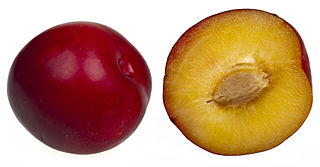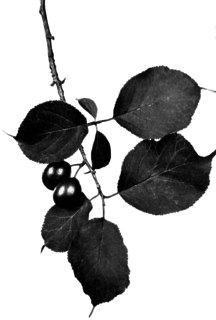
A plum is a fruit of the subgenus Prunus of the genus Prunus. The subgenus is distinguished from other subgenera in the shoots having terminal bud and solitary side buds, the flowers in groups of one to five together on short stems, and the fruit having a groove running down one side and a smooth stone.

Prunus mume is an Asian tree species classified in the Armeniaca section of the genus Prunus subgenus Prunus. Its common names include Chinese plum and Japanese apricot. The flower is usually called plum blossom. This distinct tree species is related to both the plum and apricot trees. Although generally referred to as a plum in English, it is more closely related to the apricot.
In Chinese, Japanese and Korean cooking, the fruit of the tree is used in juices, as a flavouring for alcohol, as a pickle and in sauces. It is also used in traditional medicine.

Prunus spinosa, called blackthorn or sloe, is a species of flowering plant in the rose family Rosaceae. It is native to Europe, western Asia, and locally in northwest Africa. It is also locally naturalised in New Zealand, Tasmania and eastern North America.

Prunus armeniaca, the most commonly cultivated apricot species, also called ansu apricot, Siberian apricot, Tibetan apricot, is a species of Prunus, classified with the plum in the subgenus Prunus. The native range is somewhat uncertain due to its extensive prehistoric cultivation, though almost certainly somewhere in Asia. It is extensively cultivated in many countries and has escaped into the wild in many places.

Prunus padus, known as bird cherry, hackberry, hagberry, or Mayday tree, is a flowering plant in the rose family Rosaceae. It is a species of cherry, a deciduous small tree or large shrub up to 16 m tall. It is the type species of the subgenus Padus, which have flowers in racemes. It is native to northern Europe and northern Asia

Prunus cerasifera is a species of plum known by the common names cherry plum and myrobalan plum. It is native to Southeast Europe and Western Asia, and is naturalised in the British Isles and scattered locations in North America.

Prunus salicina, commonly called the Japanese plum or Chinese plum, is a small deciduous tree native to China. It is now also grown in fruit orchards in Korea, Japan, the United States, and Australia.

The bullace is a variety of plum. It bears edible fruit similar to those of the damson, and like the damson is considered to be a strain of the insititia subspecies of Prunus domestica. Although the term has regionally been applied to several different kinds of "wild plum" found in the United Kingdom, it is usually taken to refer to varieties with a spherical shape, as opposed to the oval damsons.

Prunus maritima, the beach plum, is a species of plum native to the East Coast of the United States, from Maine south to Maryland. Although sometimes listed as extending to New Brunswick, the species is not known from collections there, and does not appear in the most authoritative works on the flora of that Canadian province.

Prunus subcordata, known by the common names Klamath plum, Oregon plum, Pacific plum and Sierra plum, is a member of the genus Prunus, native to the western United States in California and western and southern Oregon. It grows in forests, most often at low elevation near the coast, but it is also in the Sierra Nevada and Cascades; it grows at altitudes of 100–1,900 m. P. subcordata var. subcordata, Klamath plum, is also found in Washington.

Prunus americana, commonly called the American plum, wild plum, or Marshall's large yellow sweet plum, is a species of Prunus native to North America from Saskatchewan and Idaho south to New Mexico and east to Québec, Maine and Florida.
Wild plum is a common name for several trees with edible fruits, and may refer to:
Prunus eremophila, also known by its common name Mojave Desert plum, is a rare species of plum native to California.

Prunus angustifolia pronounced, known commonly as Chickasaw plum, Cherokee plum, Florida sand plum, sandhill plum, or sand plum, is a North American species of plum-bearing tree. It was originally cultivated by Native Americans before the arrival of Europeans While Prunus is the classical name for European plums, angustifolia refers to its narrow leaves.
Flowering plum is a common name for several species in the plum genus (Prunus) cultivated for their flowers, and may refer to:

Prunus umbellata, called flatwoods plum, hog plum and sloe plum, is a plum species native to the United States from Virginia, south to Florida, and west to Texas.

Prunus gracilis, called the Oklahoma plum, sour plum, and sand plum, is native to the south-central United States.
















